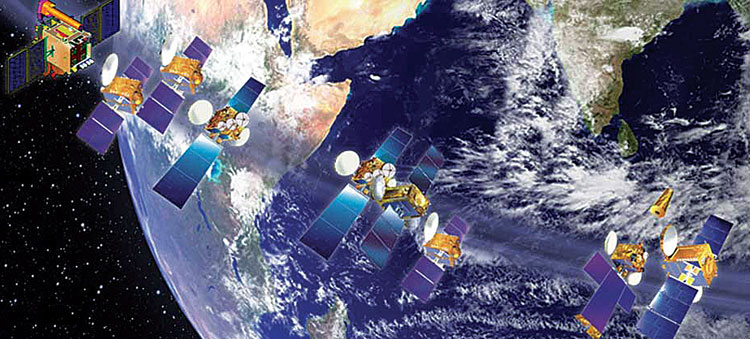INDIAN ARMED FORCES CHIEFS ON
OUR RELENTLESS AND FOCUSED PUBLISHING EFFORTS

SP Guide Publications puts forth a well compiled articulation of issues, pursuits and accomplishments of the Indian Army, over the years

I am confident that SP Guide Publications would continue to inform, inspire and influence.

My compliments to SP Guide Publications for informative and credible reportage on contemporary aerospace issues over the past six decades.
Safeguard Satellites
Unless, ISRO develops the capability of safeguarding its satellites from anti-satellite weapons of the enemy, this vital segment of national security can easily be compromised

India’s endeavours into the domain of space technology began as early as in 1962 with the setting up of the Indian National Committee for Space Research (INCOSPAR). Thereafter, it was in August 1969, seven years after the foray into this domain, the Indian space Research Organisation (ISRO) was set up with its headquarters at Bangalore, now Bengaluru. Following the creation of ISRO, the Government of India constituted the Space Commission in June 1972 as well as established the Department of Space (DOS) and brought the newly created ISRO under its control in the year 1972. The purpose of these measures adopted by the Government was to provide the impetus for rapid development of space technology and the variety of related applications to assist in the all-round development of the nation. The domain of space technology was entirely a new field the nation was venturing into without any assistance from or collaboration with any nation with proven capability in this field. However, as this was an entirely new field for Indian scientists, dependence on foreign sources for some high end technologies such as solar cells to power satellite in space, was natural and only to be expected. This deficiency was corrected a few years ago when ISRO acquired the technology from the United States (US) for making space solar cells and hence has been in a position to mass produce this item in India. Bharat Electronics Limited (BEL), the leading firm in the Indian public sector is now responsible for producing solar cells to power satellites while in space. This has resulted in enormous savings of precious foreign exchange as the requirement of this item is sizeable. Today, ISRO is supported by over a dozen Indian laboratories and organisations dealing with space technology.
The first satellite that was made by ISRO marking its successful foray into the space age, was in 1975. The satellite was christened as “Aryabhata”, being named after the first of the major mathematician-astronomers from the classical age of Indian mathematics and Indian astronomy. Aryabhata was born in the year 476 AD. There is uncertainty about his place of birth, but it is known that he had his early education in Nalanda in Bihar. He was one of the earliest Indian mathematicians and astronomers whose pioneering work in these two fields is still studied by scholars even of modern times. Naming after him the first satellite that was successfully launched by India, was perhaps the most appropriate thing to do.
Over the last forty five years, the Indian Space programme has made impressive progress through a well-integrated, selfreliant programme. ISRO has launched nearly 200 satellites since the launch of Aryabhata, for use by the nation including its armed forces. In addition, ISRO has launched satellites for a number of nations as well purely as a commercial venture. Today, ISRO is regarded as one of the largest and most successful space agencies in the world.
While Rakesh Sharma, an officer serving in the Indian Air Force, was the first Indian citizen to undertake a flight into space on April 02, 1984, it was not on board an Indian space vehicle; but on one called Soyuz T-11 that was launched by the Union of Soviet Socialist Republic. Although in 2003, the then Prime Minister Atal Bihari Vajpayee had urged ISRO to work towards sending a man to the Moon, the space agency is yet to achieve this feat. However, ISRO has successfully carried out missions to the Moon by way of Chandrayaan One and Chandrayaan Two. Also, on September 14, 2014, ISRO successfully launched its Mars Orbiter Mission called “Mangalyaan”. As per reports in the media, human spaceflight by ISRO that was planned for December 2021, is delayed by a year. The spacecraft for the Moon mission named as Gaganyaan, will be launched by the indigenous GSLV III rocket.
ISRO has been playing a significant role in the defence of the nation by launching satellites that provide extremely reliable communication and reconnaissance facilities, both of critical importance for the Indian armed forces. The relevance of these two facilities have been clearly highlighted in the recent conflict in Eastern Ladakh between the Indian Army and the People’s Liberation Army of China. A recent event of significance is that ISRO has displayed the capability to destroy a satellite in orbit which made India the fourth country to do so after the US, Russia and China. One of ISRO’s defunct satellites was destroyed by a missile fired from the ground.
Investment by the nation in building up the capabilities of ISRO in the domain of space technology has without doubt, been enormous and with passage of time, will only continue to escalate. The network of satellites that ISRO has place in orbit will not only have to be replaced periodically but also expanded considerably to meet with the ever increasing requirements of the nation. However, unless and until ISRO develops the capability of not only launching more satellites, but also to safeguard the network of satellites from anti-satellite weapons of the enemy, this vital segment of national security can easily be compromised.





